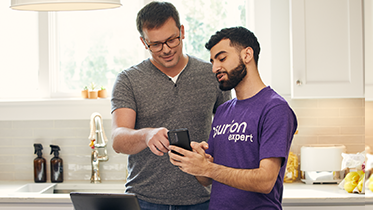You have a big project due in an hour, but your computer decides now is the best time to shut down so it can finally launch an update you've been putting off. It's the epitome of stress. You're up against the clock. So when the computer doesn't respond to your shutdown command—or worse, sits on the shut down screen forever—it's a problem.
Don't worry, though, we can help. At Asurion, we're here for you and your tech—whether your computer won't connect to Wi-Fi or your camera won't work at all. Here's how to shutdown Windows™ 11.
What to do if your computer is stuck on the shutdown screen
If Windows™ has been stuck on the shutdown screen for a while, here's what you can do to force a shutdown:
- Hold down the power button until the computer shuts off.
- Remove the computer battery, if you can.
- Give the computer time for the battery to die.
What to do if your computer isn't responding
When Windows 11 won't shut down but your computer isn't stuck on the shutdown screen, try these troubleshooting steps instead.
Check for programs still running
Your computer might be having trouble shutting down because it still has a program running. You can use Task Manager to find and close any apps that might be causing the hold up.
Here's how to force-quit programs by using Task Manager:
- Press Ctrl + Alt + Del at the same time.
- Select Task Manager.
- Click More Details in the bottom-left corner.
- Under Processes, you should see a table with categories for Processor, Memory, Disk, Network, and a corresponding list of applications.
- Double-click the Applications column. This will give you a list of applications and the resources they're using. Select End Task for any apps you notice are using the most energy.
If you find there's a software update running, avoid turning off the computer until after the update is finished. Forcing it off in the middle could cause trouble in the future.

You can’t work when your computer doesn’t want to
Get it repaired fast at one of our stores. Just stop in or make an appointment⎯we'll handle the rest.
Update your software
Regular updates keep your devices working properly and fix security issues and other glitches. Here's how to update your software:
- Open the Start menu.
- Select Settings.
- Select Windows Update > Check for updates.
- Select Download and install > Restart Now.
Check your drivers
Normally, your drivers—the programs responsible for how your computer communicates with other programs and accessories—get updated along with your software. In case they don't, for whatever reason, you can update those drivers manually. Here's how:
- In the search box on the taskbar, type “device manager", then select Device Manager.
- Select a category to see a list of devices, and right-click the one you'd like to update. Then select Search automatically for updated driver software > Update Driver. If a driver update is available, the computer will update the device driver.
Turn off Fast Startup
When this setting is turned on and you shut down your computer, Windows will save the system files it used during the startup process and keep them open to make everything work faster.
By default, Fast startup is turned on in Windows 11. Follow these steps to turn that setting off:
- Type “control panel" into the Start menu search bar.
- Click View by to see a list of options, and choose Large icons or Small icons.
- Open Power Options.
- On the left pane, click Choose what the power buttons do.
- From Shutdown settings, clear the Turn on fast startup (recommended) checkbox.
- Click Save changes. Then close all running apps, and try to shut down your computer.
Run the power troubleshooter
If there's a flaw in the code of the program running the computer's shut downs, the power troubleshooter should find and correct it.
Follow these steps to run the Power troubleshooter:
- In the Start menu search bar, type “troubleshoot settings".
- Select the item under Best match.
- Click Additional troubleshooters.
- Select Power, then click Run the troubleshooter.
Run the Windows update troubleshooter
Your computer might not be shutting down because Windows is stuck managing an update. In this case, running the Windows Update troubleshooter should fix the problem.
- In the Start menu search bar, type “troubleshoot settings".
- Select the item under Best match.
- Click Additional troubleshooters.
- Select Windows Update, then click Run the troubleshooter.
Force your computer to shut down
If all else fails, force a shutdown. Whether by holding down the power button until the computer shuts off or removing the battery, this step gives the device a chance to close all of its running programs and try to launch them again properly.
If you've tried these steps and still need a little help, we're right around the corner. Schedule a repair at the nearest uBreakiFix® by Asurion store and our certified experts can get your device back up and running as soon as the same day.





